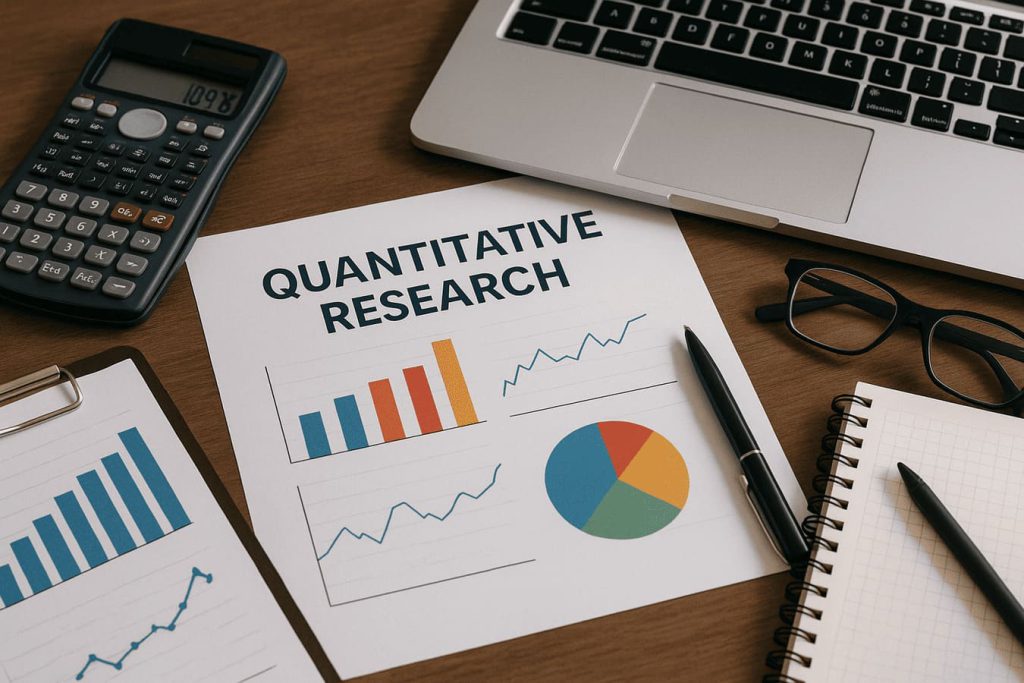Quantitative Research Tools

I’ve got news for you.
Your gut instinct is failing your business. That’s right. The “feeling” that guides your biggest decisions? It’s probably wrong!
… But what if you could replace those shaky hunches with rock-solid evidence? What if you could see the future of your business with startling clarity?
Ready for the red pill? Let’s dive into the world that’s hiding in plain sight.
Table of Contents
✅ Listen to this PODCAST EPISODE here:
Introduction to Quantitative Research
Numbers don’t lie. They can’t. That’s the beautiful, brutal simplicity behind quantitative research.
While your competitors waste time on opinions and office politics, quantitative research tools deal with hard data points that paint the unvarnished truth about your market.
Why should this matter to you? Because การวิจัยระหว่างประเทศของ SIS discovered something shocking: data-driven organizations are 23% more likely to acquire customers than their competition. Not 5%. Not 10%. Twenty-three percent.
Think about that for a second.
The modern business landscape doesn’t reward gut feelings anymore. It rewards evidence. Quantitative research tools deliver concrete proof for making smarter, more profitable decisions.
Quantitative Data Collection Methods

These are the approaches that separate amateurs from professionals.
แบบสำรวจและแบบสอบถาม
Let’s be honest. Most surveys suck.
However, a brilliantly crafted survey remains unbeatable for collecting standardized data at scale. Quantitative research tools like digital surveys let you reach thousands of respondents for pennies on the dollar compared to traditional methods.
Here’s what nobody tells you: behind those simple-looking questions lies sophisticated methodology designed to eliminate bias and extract truth from noise. Today’s platforms make it ridiculous how easily you can launch professional-grade research in minutes. Not weeks. Not months. Minutes.
การทดลอง
Want to know what actually causes what? Experiments are your secret weapon.
Unlike passive observation, experiments manipulate variables to establish actual cause-and-effect relationships. This approach delivers the highest-quality evidence for making business decisions.
A multinational food company suspected packaging influenced buying behavior but couldn’t prove it. Using experimental quantitative research tools, they tested four package designs with identical products inside. The winning design boosted purchase intent by 41%. That’s not a typo. Forty-one percent from changing some colors and shapes.
Longitudinal Studies
Longitudinal studies track the same variables repeatedly over extended periods, making them irreplaceable quantitative research tools for detecting patterns invisible to snapshot research.
An automotive manufacturer partnered with การวิจัยระหว่างประเทศของ SIS to follow 1,000 vehicle owners over five years. The resulting data revealed maintenance patterns that completely upended their service model, boosting service revenue 31% while simultaneously improving customer satisfaction scores. That’s the holy grail—making more money while making customers happier.
These approaches require patience, but they deliver insights impossible to gain any other way. And in business, unique insights create unfair advantages.
โพล
Need quick answers to burning questions? Polls deliver the goods.
As agile quantitative research tools, polls provide instant snapshots of opinion or behavior. While less comprehensive than full surveys, their speed makes them indispensable for time-sensitive decisions.
Here’s a story that’ll make you rethink your approach: A political consulting firm needed immediate feedback on messaging during a campaign. Using rapid-response polling quantitative research tools, they tested three message variations with 500 likely voters. Within hours—not days, not weeks, hours—they had conclusive data showing a clear 23% preference for one approach. They pivoted immediately while their opponent kept using ineffective messaging. The election was decided by less than 2%. The difference? Data.
Digital polling has transformed what used to take weeks into something accomplished over lunch. The companies that understand this operate at a completely different speed than their competitors.
สัมภาษณ์
Don’t make this common mistake: dismissing interviews as “just qualitative.”
When conducted with standardized questions and numerical rating scales, interviews become powerful quantitative research tools that combine human connection with mathematical rigor.
A healthcare provider used structured telephone interviews to assess patient satisfaction. By quantifying responses on a 10-point scale across eight service dimensions, they identified specific improvement opportunities that raised satisfaction scores by 17% in twelve months. But here’s what matters: patients didn’t just say they were happier—they actually referred 23% more new patients. Real business impact.
The human element of interviews consistently delivers higher response rates and more complete answers than cold, impersonal survey methods. Never underestimate the power of conversation—just make sure you’re quantifying it.
Quantitative Data Analysis Tools

Collecting data is just step one. The game-changing magic happens when you analyze it with the right tools.
Statistical Software
Programs like SPSS, SAS, and Stata transform raw data into million-dollar insights through statistical procedures. These quantitative research tools encompass a range of techniques, from basic descriptive statistics to complex multivariate analyses, which reveal hidden relationships within your data.
Here’s what nobody tells you: most of these tools now offer interfaces that non-statisticians can actually use. The days of needing a specialized data team for every analysis are over.
Programming Languages
For the ultimate analytical firepower, nothing touches programming languages like R and Python. These quantitative research tools provide limitless analytical possibilities for organizations needing complete control over their data destiny.
A manufacturing client faced quality control nightmares across 12 facilities. Using Python with specialized data science libraries, SIS International’s analytics team built a predictive model that slashed defects by 43% and saved $1.2 million annually. The ROI? Over 2,000%. Not a typo.
Don’t panic—visual programming interfaces have made these languages more accessible than ever. You don’t need to become a coder to leverage their power.
Spreadsheet Software
Excel isn’t sexy. But it’s still making millionaires.
For countless organizations, spreadsheet software remains among the most widely used quantitative research tools because of its ridiculous accessibility and flexibility. Modern spreadsheet applications have transcended their humble beginnings, now offering sophisticated visualization and even machine learning capabilities that would have seemed like science fiction a decade ago.
Visualization Tools
Want a secret weapon for persuading stakeholders? Visualize your data.
Visualization quantitative research tools transform complex numerical data into intuitive visual stories that reveal patterns impossible to see in raw numbers. From simple bar charts to interactive dashboards, visualization tools make complex data accessible to decision-makers who wouldn’t go near a statistical table. In other words, most executives.
Examples of Quantitative Research in Practice
Let’s look at how quantitative research tools create actual business results.
การวิจัยทางการตลาด
Here’s a harsh truth: understand your customers or watch competitors steal them.
Market research represents the most common application of quantitative research tools, helping businesses understand customer preferences, market trends, and competitive positioning before it’s too late.
A consumer packaged goods company working with การวิจัยระหว่างประเทศของ SIS conducted a survey of 2,500 consumers across five markets. The resulting data revealed a significant unmet need that their product team had completely missed. Their response? A new product line that generated $17 million in first-year sales. From a survey that cost less than hiring a single employee for a year.
Today’s market research tools combine traditional methodologies with digital capabilities, delivering faster insights at a fraction of historical costs.
Social Sciences
Human behavior follows patterns. These patterns predict profits.
Social scientists use quantitative research tools to understand everything from voting behavior to educational outcomes—and smart businesses are stealing these methods. The methodologies developed in academic settings consistently find powerful applications in business contexts. Ignore this crossover potential at your peril.
ดูแลสุขภาพ
When lives are at stake, data matters more than anywhere else.
Healthcare organizations leverage quantitative research tools for everything from clinical trials to process optimization.
A hospital network analyzed patient flow data using healthcare analytics software. The resulting improvements cut emergency department wait times by 37 minutes—improving both patient outcomes and satisfaction scores. The financial impact? A 12% increase in emergency department capacity without adding a single square foot of physical space. Pure operational efficiency.
The evidence-based approach powered by quantitative research has completely transformed healthcare delivery worldwide—and the methods translate directly to business operations.
The Digital Transformation of Quantitative Research

Research has changed more in the last five years than in the previous fifty. Miss these shifts at your peril.
Mobile-First Research Methods
Your customers live on their phones. Your research should meet them there.
Mobile-optimized quantitative research tools have exploded response rates and data quality by engaging participants where they already spend hours daily—on their smartphones. Additionally, the geo-location capabilities of mobile research add contextual dimensions impossible with traditional methods, letting companies understand not just what people think, but where and when they think it. This spatial-temporal context is pure gold.
AI and Machine Learning Applications
AI isn’t eliminating researchers—it’s giving them superpowers.
AI-powered quantitative research tools analyze patterns in datasets too massive for human comprehension, identifying hidden correlations that translate directly to competitive advantage.
The predictive capabilities of today’s AI-enhanced quantitative research tools allow organizations to shift from reactive to proactive decision-making, anticipating market changes while competitors are still looking in the rearview mirror.
Real-Time Analytics Dashboards
Waiting weeks for research results is business suicide today.
Real-time analytics have transformed quantitative research tools from occasional projects into continuous intelligence streams providing instant feedback on business performance.
The democratization of data through intuitive interfaces means insights no longer get trapped in research departments—they flow directly to decision-makers precisely when needed. That’s when data becomes action.
Ethical Considerations in Quantitative Research
With great data comes great responsibility. The ethical dimension of quantitative research tools isn’t just about compliance—it’s about competitive advantage.
Data Privacy and Consent
The wild west days of data collection are dead and buried.
Modern quantitative research tools must navigate increasingly complex privacy regulations while maintaining ethical standards that respect participant rights. The smartest research organizations view privacy not as an obstacle but as an opportunity to build trust with participants, resulting in more honest, accurate data. Trust creates better insights.
Algorithmic Bias and Fairness
Your algorithms contain hidden prejudices you never intended. Find them before they cost you. As quantitative research tools increasingly incorporate automated analysis, organizations must guard against perpetuating existing biases.
The most sophisticated research organizations now employ specialized fairness metrics to ensure their analytical approaches deliver accurate insights across all population segments. This isn’t just about doing good—it’s about seeing clearly.
Data Security Protocols
One breach can destroy years of hard-earned trust. And your business along with it.
Today’s quantitative research tools must employ fortress-level security measures to protect sensitive information throughout the research process.
Leading organizations implement end-to-end encryption, anonymization techniques, and strict access controls within their quantitative research tools to safeguard both participant privacy and organizational reputation. In the trust economy, security isn’t a cost center—it’s survival.
Advantages and Disadvantages
Every approach has strengths and blind spots. Understanding both sides of quantitative research tools is critical for success.
ข้อดี
ความเที่ยงธรรม: Quantitative data provides numerical evidence that exists independent of bias or opinion.
Generalizability: Properly designed quantitative research extends findings to larger populations with mathematical confidence.
Replicability: Standardized procedures mean studies can be repeated to verify findings.
Quantitative research tools excel at providing concrete evidence that cuts through opinion and delivers actionable intelligence when it matters most.
ข้อเสีย
Lack of Context: Numbers tell what but often not why. The numbers identified the problem; conversations explained it.
Limited Flexibility: Structured tools may miss unexpected insights. Sometimes the most valuable answer is one you didn’t think to ask about.
Potential for Bias: If not designed carefully, quantitative research can amplify existing assumptions.
Key Insights: What You Need to Remember
✅ Quantitative research tools transform subjective questions into objective data that drives better business decisions.
✅ Today’s tools range from accessible survey platforms to sophisticated statistical software, making data-driven research possible for organizations of all sizes.
✅ The most effective research approaches often combine multiple methods (surveys + observations + analytics) for comprehensive understanding.
✅ Proper analysis is as crucial as proper data collection—the most valuable insights often emerge during the analytical phase.
✅ While powerful, quantitative methods have limitations that are best addressed by complementing them with qualitative approaches.
✅ SIS International’s research methodology integrates cutting-edge tools with experienced analysis to deliver actionable intelligence.
✅ The most successful organizations don’t just collect data—they build systems to transform that data into strategic action.
What Makes SIS International a Top Quantitative Research Partner?
In a world drowning in data but starving for insights, choosing the right research partner makes all the difference.
Why Choose SIS International for Your Quantitative Research Needs
- GLOBAL REACH: เอสไอเอส อินเตอร์เนชั่นแนล‘s worldwide presence enables research across markets and cultures with local expertise in each region.
- 40+ YEARS OF EXPERIENCE: Four decades of research excellence has refined methodologies that deliver reliable, actionable insights.
- EXTENSIVE GLOBAL DATABASES: Access to proprietary respondent pools across industries and demographics ensures research that truly represents your target markets.
- IN-COUNTRY STAFF SPEAKING 33+ LANGUAGES: Native researchers who understand cultural nuances ensure accuracy beyond mere translation.
- SOPHISTICATED DATA ANALYTICS: Advanced analytical capabilities transform raw data into strategic recommendations with clear business impact.
- AFFORDABLE RESEARCH SOLUTIONS: Scalable approaches deliver enterprise-quality insights within budgets of all sizes.
- CUSTOMIZED METHODOLOGIES: Tailored research designs address your specific business questions rather than forcing one-size-fits-all approaches.
Frequently Asked Questions About Quantitative Research Tools
What’s the difference between quantitative and qualitative research?
Quantitative research focuses on numerical data that can be measured and analyzed statistically, while qualitative research explores non-numerical information like opinions, motivations, and experiences. The best research strategies often employ both approaches for comprehensive understanding.
How large should my sample size be for reliable quantitative research?
Sample size requirements depend on factors including population size, desired confidence level, and expected variance. While larger samples generally provide more reliable results, properly designed studies can deliver valid insights with surprisingly modest sample sizes. For typical business research, samples of 400-1,000 respondents often provide statistically valid results with reasonable margins of error.
Which quantitative research method delivers the fastest results?
Polls and certain types of automated surveys can deliver preliminary results within hours or even minutes. Digital research platforms have dramatically reduced timelines for even complex projects, with many comprehensive studies now completed within 2-3 weeks versus the months required in traditional approaches.
How can I ensure my quantitative research is free from bias?
Eliminating bias requires careful attention throughout the research process, including proper sampling methods, neutrally worded questions, and appropriate statistical techniques. Working with experienced research professionals significantly reduces the risk of common biases that can undermine research validity.
What’s the most cost-effective quantitative research method for startups?
Digital survey platforms offer exceptional value for many research questions, with basic projects sometimes possible for under $1,000. However, even small companies should consider the business impact of decisions rather than just research costs—a slightly more expensive approach that delivers better insights can provide exponentially higher ROI.
How can I make sense of complex quantitative data without statistical expertise?
Modern visualization tools and dashboards make data interpretation more accessible than ever before. Many research providers now include intuitive data portals that allow non-techn ical users to explore findings interactively. Additionally, working with analysts who can translate statistical findings into clear business recommendations bridges the technical gap.
สถานที่ตั้งโรงงานของเราในนิวยอร์ก
11 E 22nd Street, ชั้น 2, นิวยอร์ก, NY 10010 T: +1(212) 505-6805
เกี่ยวกับ เอสไอเอส อินเตอร์เนชั่นแนล
เอสไอเอส อินเตอร์เนชั่นแนล เสนอการวิจัยเชิงปริมาณ เชิงคุณภาพ และเชิงกลยุทธ์ เราให้ข้อมูล เครื่องมือ กลยุทธ์ รายงาน และข้อมูลเชิงลึกเพื่อการตัดสินใจ นอกจากนี้เรายังดำเนินการสัมภาษณ์ การสำรวจ การสนทนากลุ่ม และวิธีการและแนวทางการวิจัยตลาดอื่นๆ ติดต่อเรา สำหรับโครงการวิจัยการตลาดครั้งต่อไปของคุณ



